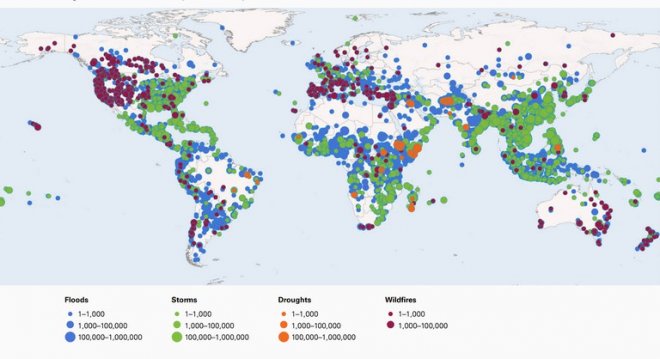World Meteorological Organization declares El Niño has started
El Niño conditions are underway in the tropical Pacific, which will likely result in record-high temperatures in many parts of the world, along with severe droughts, the World Meteorological Organization said Tuesday.“El Niño conditions have developed in the tropical Pacific for the first time in seven years, setting the stage for a likely surge in global temperatures and disruptive weather and climate patterns,” the organization said.
It is expected to be at least of moderate strength, said the specialized United Nations agency that looks into weather and atmospheric science.
El Niño, a naturally occurring weather pattern characterized by hot ocean temperatures in the equatorial Pacific, can significantly affect weather and storm patterns worldwide. It currently takes place in a climate changed by human activities.
There is “a 90% probability” of the El Niño event continuing during the second half of 2023, according to the World Meteorological Organization’s new forecast update, which combines forecasts and expert guidance from around the world.
“The onset of El Niño will greatly increase the likelihood of breaking temperature records and triggering more extreme heat in many parts of the world and in the ocean,” Petteri Taalas, the organization’s secretary-general, said.
He said the announcement signals governments worldwide should prepare to limit the impacts on health, ecosystems, and economies.
“Early warnings and anticipatory action of extreme weather events associated with this major climate phenomenon are vital to save lives and livelihoods,” Taalas said.
The U.S. National Ocean and Atmospheric Administration has predicted a 56% chance that this year’s El Niño will be a strong event, with an 84% chance of at least a moderate event.
Scientists have found that the frequency and ferocity of such extreme events will increase this century due to rising global temperatures.
El Nino could bring record temperatures
El Niño occurs on average every two to seven years, and episodes typically last nine to 12 months. The region has seen the cooling influence of La Niña for several years, conditions which ended in March this year.
Scientists say the past eight years have been the eight warmest on record globally, with 2016 being the hottest on record. The World Meteorological Organization (WMO) says that is primarily due to the “double whammy” of “an exceptionally strong El Niño” event and human-induced warming from greenhouse gasses.
 A Filipino worker cleaning garbage looks at a truck navigating a flooded road in suburban Mandaluyong, east of Manila, Philippines, as monsoon downpours intensify while Typhoon Nepartak exits the country on July 8, 2016. Credit: AP
A Filipino worker cleaning garbage looks at a truck navigating a flooded road in suburban Mandaluyong, east of Manila, Philippines, as monsoon downpours intensify while Typhoon Nepartak exits the country on July 8, 2016. Credit: APAccording to a May report by the WMO, it is predicted that within the next five years and the entire five-year span, there will be a new record for the warmest temperatures ever recorded, surpassing the 2016 record.
Additionally, the report states that there is a 66% probability that the average global near-surface temperature for at least one year between 2023 and 2027 will exceed 1.5°C above pre-industrial levels.
“This is not to say that in the next five years we would exceed the 1.5°C level specified in the Paris Agreement because that agreement refers to long-term warming over many years,” said Chris Hewitt, the WMO’s director of climate service.
“However, it is yet another wake-up call, or an early warning, that we are not yet going in the right direction to limit the warming to within the targets set in Paris in 2015 designed to substantially reduce the impacts of climate change.”
The WMO said Tuesday that the effect on global temperatures usually plays out in the year after its development and will likely be most apparent in 2024.
Last year, the average global temperature, which has not crossed the 1.5 C threshold set by the Paris climate agreement, was about 1.15 C above the 1850-1900 average.
Asia could see severe drought
In most of Asia and Australia, El Nino would mean warmer, drier weather conditions and could cause severe drought, as well as fuel typhoons, the WMO said.
On June 30, the ASEAN Specialised Meteorological Centre (ASMC) said that El Niño conditions are expected to be established in the region during July and August.
“Once established, these conditions are likely to strengthen gradually over the second half of 2023,” it said.
“The typical impact of El Niño on Southeast Asia is drier-than-average rainfall conditions, including for much of the Maritime Continent during June to August. Warmer temperature conditions typically follow drier periods.”
The ASMC also said an increased risk of elevated hotspot activity and smoke haze could be expected over the fire-prone areas of the southern ASEAN region during extended periods of dry weather.
 Indian women walk home after collecting drinking water from a well at Mengal Pada in Thane district in Maharashtra state, India, after a heatwave and severe drought conditions struck the region, May 4, 2016. Credit: AP
Indian women walk home after collecting drinking water from a well at Mengal Pada in Thane district in Maharashtra state, India, after a heatwave and severe drought conditions struck the region, May 4, 2016. Credit: APLast month, according to the state-affiliated Global Times newspaper, the China Meteorological Administration said that El Niño is expected to bring more extreme weather to China.
Zhou Bing, head of the administration’s meteorological service, told reporters that there are suggestions, dating back to 1850, that the return of El Niño could lead to record high temperatures in 2023 or 2024.
Zhou said that even if El Niño becomes a moderate event, it could surpass the record for the warmest global weather in 2016.
During El Niño years, there are typically higher temperatures in mostly northern, eastern, and central regions, leading to extreme drought in certain areas, according to data from the National Climate Center. Similarly, more rainfall in southern China and a warmer winter are also expected.
In recent weeks, parts of China have been experiencing record-breaking heat, while others have seen heavy rainfall and flooding.
Edited by Mike Firn.
[圖擷取自網路,如有疑問請私訊]
|
本篇 |
不想錯過? 請追蹤FB專頁! |
| 喜歡這篇嗎?快分享吧! |
相關文章
AsianNewsCast






















